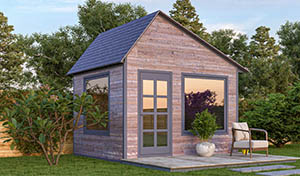Sunday, November 10, 2024
How to plan a diy 10x12 garden shed for your yard

Alright, so you're finally ready to take on the awesome challenge of building your own garden shed. You're picturing that organized space for all your tools, gardening supplies, and maybe even a little workshop nook. It's gonna be fantastic! But where do you even start? Don't worry, we're going to walk through this together, step-by-step, and turn your shed dreams into reality.
First Things First: The Planning Stage
This is like the recipe for your shed. It's where you outline everything from the ingredients (materials) to the exact steps (construction). Don't skip this, even if you're itching to get your hands dirty!
1. Location, Location, Location:
Where will your shed reside? Think about:
Sun and Shade: Do you want it to be bright and sunny for drying things or shaded for storing sensitive tools?
Access: Is it easy to get in and out with a wheelbarrow or lawnmower?
Drainage: Will water pool around the shed, or is the ground sloped for good drainage?
Setbacks: Check your local building codes for minimum distances from property lines and other structures.
2. The Blueprint: Design & Size:
Standard Sheds: You can buy pre-designed plans, or even kits, which is super convenient. A 10x12 shed is a popular size, offering good storage without being overwhelming.
Custom Design: Want to add a window? A door on a different side? Maybe a lean-to roof for your bicycle? With a little research and some basic sketching, you can personalize your shed.
Foundation Options: Do you want a simple concrete slab, pressure-treated wood, or something else entirely? This affects the cost and complexity of the foundation.
3. Budget & Materials:
Cost Breakdown: Figure out your budget by researching prices for lumber, roofing, siding, windows, doors, hardware, and any extras you want. Factor in labor costs if you're not doing the entire project yourself.
Material Selection: Do you want pressure-treated lumber for the foundation and floor? Cedar for siding? Shingles or metal for the roof? Choose materials that suit your style, budget, and maintenance preference.
4. Tools & Equipment:
The Essentials: You'll need basic tools like a hammer, level, tape measure, saw, drill, and screwdriver. A circular saw, miter saw, and table saw make things a lot easier, but can be rented if you don't own them.
Safety First: Don't forget safety gear: eye protection, work gloves, earplugs, and a good ladder for those high-up tasks.
Now It's Time to Get Building!
1. Laying the Foundation:
Level is Key: Make sure your foundation is perfectly level, using a long level and a spirit level.
Anchoring: Secure the foundation to the ground with concrete anchors or bolts for stability. This is especially important if you live in an area prone to strong winds.
Adding a Floor: If you're going with a wood floor, make sure it's strong enough to support the weight of your belongings. Pressure-treated lumber is a great choice for floor joists.
2. Framing the Walls:
Measuring Up: Double-check all your measurements before you start cutting lumber. A single miscalculation can throw everything off.
Creating the Walls: Use stud framing techniques to build your walls, adding extra bracing for strength and stability.
Adding Insulation: If you want a more comfortable shed, add insulation to the walls and ceiling.
3. Roofing:
Choosing the Right Roof: Consider the slope of your roof, the type of roofing material, and the overall style of your shed.
Framing the Rafters: Use pre-cut rafters or build your own, ensuring proper spacing and support.
Laying the Roof Sheathing: Attach plywood sheathing to the rafters for a smooth, durable base for the roofing material.
4. Siding & Finishing Touches:
Siding Options: You can choose from various siding materials, like wood, vinyl, metal, or composite.
Adding the Windows and Doors: Make sure your windows and doors are properly installed, including weather stripping and flashing to prevent leaks.
Painting or Staining: Give your shed a fresh coat of paint or stain to protect it from the elements and enhance its aesthetic appeal.
Tips & Tricks:
Pre-Drill Holes: This prevents wood from splitting when driving screws.
Use a Level: Don't underestimate the power of a level! It ensures everything is straight and even.
Double-Check Your Measurements: This is crucial throughout the building process.
Take Your Time: It's okay to work on the shed at your own pace, especially if you're a DIY novice.
Don't Be Afraid to Ask for Help: There's no shame in asking a friend or family member for assistance, or even hiring a professional for specific tasks.
And finally, the best part: Enjoying your finished shed!
Your DIY garden shed is now a testament to your hard work and creativity. It's a space to organize, create, and enjoy the fruits of your labor. So go ahead, plant some flowers, put away your tools, and revel in the satisfaction of a job well done. Happy shedding!
No comments:
Post a Comment
Note: Only a member of this blog may post a comment.